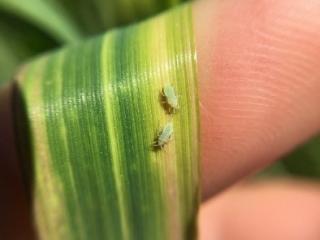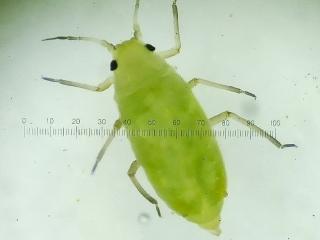Russian wheat aphid
- Grass Patch
Lucy Burrows (Clarke and Stokes) has recently found Russian wheat aphid (RWA) feeding damage in a wheat crop at Grass Patch. The wheat plants were at first node (GS31). The crop was sown with an insecticidal seed dressing and no RWA colonies were found on the symptomatic plants. The crop will be monitored.
Growers are urged to monitor wheat and barley crops for this pest.
How to monitor and diagnose Russian wheat aphid
The three main cereal aphids in WA are corn aphids, oat aphids and the newly introduced RWA. For more information on diagnosing corn and oat aphids refer to the DPIRD Diagnosing cereal aphids page
RWA adults are only about two millimetres long, pale yellowish green with a fine waxy coating. RWA antennae are short, as are the cone shaped siphunculi (sometimes called cornicles). A hand lens or smartphone macro lens may be useful to see them. For more information refer to the DPIRD Diagnosing Russian wheat aphid page.
Start monitoring wheat and barley crops for RWA from GS30. Inspect the edges of crops, as this is where aphids often colonise first, or where plants are under stress. Look for streaking damage near the base of newly emerged leaves.
Unlike other aphids, RWA inject a toxin into the plant that causes a noticeable loss of green colouration across the crop and, on closer inspection, white, yellow, purple or red streaking, leaf curling, stunted plant growth and loss of vigour in the affected plant.
A few RWA can cause symptoms to appear on plants as early as seven days after infestation. Plant damage symptoms will persist on plants even if RWA colonies have not survived.
RWA colonies are frequently found on the newest emerged leaves at the base.
Be mindful that RWA damage can look similar to herbicide damage, mite feeding damage or resemble wheat streak mosaic virus symptoms.
Management
This aphid is readily managed. Growers should consider applying sprays only when threshold levels are reached. For instructions and more information on using the RWA threshold calculator refer to GRDC’s Russian wheat aphid page.
For a list of insecticides registered for use on aphids (including RWA) see DPIRD’s 2022 winter spring insecticide guide or refer to the Australian Pesticides and Veterinary Medicines Authority (APVMA) products database for all chemical control options available for RWA in grains crops.
More information
For more information on RWA refer to:
- DPIRD's Russian wheat aphid: production pest page
- Cesar Australia's Russian wheat aphid identification PestBites video
- GRDC's Russian wheat aphid page
- GRDC's Just how many Russian wheat aphids is too many podcast.
For more information on RWA, or other aphids, contact DPIRD Research Scientist Svetlana Micic, Albany on +61 (0)8 9892 8591.
Author
Article authors: Svetlana Micic (DPIRD Albany) and Cindy Webster (DPIRD Narrogin).


